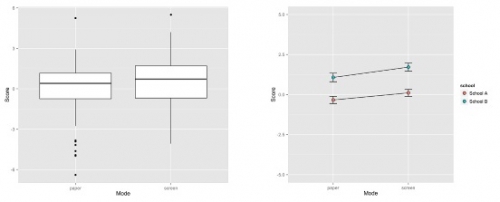With Finland giving up on handwriting at school it is perhaps only a matter of time before we all follow. Before we down our pens with the Finns, however, should we consider whether pupils actually write as well on a word processor as they do with pen and paper? We ran a small study at the end of last term that sought to answer that question.
We recruited two schools with 191 Year 7 pupils in total to undertake a short piece of creative writing. The pupils were given a short extract from a story to read and then asked to continue the story. Half of the pupils were randomly assigned to write their answers using pen and paper while half completed their answers on a word processor with the spell check turned off. The pupils were given a generous twenty minutes to complete one side of writing.
Once the work had been collected it was judged by four students studying for PhDs in creative writing using the online Comparative Judgement tool nomoremarking.com. Comparative Judgement allows responses to be judged with high reliability as it only requires judges to state which of a pair of responses is better. Following a series of decisions an algorithm computes a reliable score for each response.
The judges were asked to choose which response of each pair represented the best continuation of the story. The handwritten responses were judged separately to the typed responses to avoid any judging bias, but 20 randomly chosen handwritten responses were typed up and judged along with the typed responses so that the two scales could be directly compared.
Overall the mean score of the typed responses was slightly higher than the written responses, but statistical analyses showed that the difference was negligible Figure 1: Boxplots of the median and quartiles, and line plots of the mean and standard errors While there is little a negligible difference between the overall quality of the writing modes, it is possible that the typed responses were qualitatively different in some way. We were able to gain some insight into this possibility using the judgement data. If the judges struggled to make consistent judgements on the transcribed scripts hidden amongst the typed scripts, then it would suggest that there were different aspects of writing quality being judged in the two sets of scripts. The consistency of judgement for the transcribed scripts was very similar in the two sets of judging, however, which suggests that the writing was similar in nature. Finally, to allow you to judge for yourselves, here are extracts from the two best responses. One was on paper, one was typed. I challenge you to say which was typed and which was handwritten! Extract A The footsteps became irregular, as if the man was looking for something. Then, another set appeared, two people, wandering around the room. Their voices started up, a mumbling at first that Door couldn’t hear. They got closer and she could finally hear the words. Extract B She inched over aware that all the scientists were watching her. She opened her mouth to say something but a worried-looking scientist came over and whispered something. The only words she could hear were ‘genetic’, ‘all this girl’s fault’ and ‘she’s doomed us all.’ So it would seem that pupils can produce excellent creative writing both with pen and paper and by typing. We should be careful about generalising beyond our small sample and the domain of creative writing for now, but surely it’s time to take a close look at whether we can allow the word processor more often into the classroom.

“I thought there’d be something in here.” One of them drawled, his voice rough.






Leave A Comment